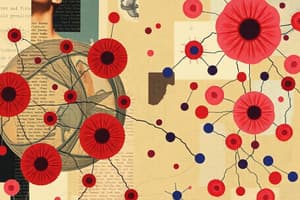Podcast
Questions and Answers
What is the primary function of neutrophils and monocytes in combating infections?
What is the primary function of neutrophils and monocytes in combating infections?
- Releasing histamines to trigger inflammation
- Engulfing and destroying bacteria and viruses (correct)
- Facilitating the formation of plasma cells
- Producing antibodies to neutralize toxins
Which type of white blood cell is specifically involved in chemotaxis?
Which type of white blood cell is specifically involved in chemotaxis?
- Monocytes
- Basophils
- Lymphocytes
- Eosinophils (correct)
What primary cell type is affected by myelogenous leukemia?
What primary cell type is affected by myelogenous leukemia?
- Red blood cells
- Endothelial cells
- Myeloid cells (correct)
- Lymphocytes
Which symptom is NOT commonly associated with the effects of leukemia?
Which symptom is NOT commonly associated with the effects of leukemia?
What substance activates the complement complex in inflamed tissues?
What substance activates the complement complex in inflamed tissues?
What is the term for the movement of cells towards an area of higher concentration of a chemotactic substance?
What is the term for the movement of cells towards an area of higher concentration of a chemotactic substance?
What is one significant consequence of the growth of leukemic cells in the bone marrow?
What is one significant consequence of the growth of leukemic cells in the bone marrow?
What is the primary purpose of opsonization in phagocytosis?
What is the primary purpose of opsonization in phagocytosis?
How do leukemic cells affect the body's metabolic resources?
How do leukemic cells affect the body's metabolic resources?
Where are granulocytes and monocytes primarily formed in the body?
Where are granulocytes and monocytes primarily formed in the body?
Which of the following is NOT a function of neutrophils and macrophages?
Which of the following is NOT a function of neutrophils and macrophages?
What can be a consequence of leukemic growth in abnormal areas, such as bones?
What can be a consequence of leukemic growth in abnormal areas, such as bones?
Which of the following products is NOT mentioned as causing chemotaxis in inflamed tissues?
Which of the following products is NOT mentioned as causing chemotaxis in inflamed tissues?
What is the composition of the bactericidal agent hypochlorite produced by myeloperoxidase?
What is the composition of the bactericidal agent hypochlorite produced by myeloperoxidase?
What process do lymphocytes and plasma cells primarily participate in?
What process do lymphocytes and plasma cells primarily participate in?
Which statement about chemotaxis is true?
Which statement about chemotaxis is true?
Which oxidizing agent is primarily associated with the killing effect of neutrophils and macrophages?
Which oxidizing agent is primarily associated with the killing effect of neutrophils and macrophages?
Phagocytes must be selective during phagocytosis to avoid ingesting what?
Phagocytes must be selective during phagocytosis to avoid ingesting what?
What type of biological structure helps regulate the enzymes used in the destruction of pathogens by phagocytes?
What type of biological structure helps regulate the enzymes used in the destruction of pathogens by phagocytes?
What role does superoxide (O2−) play in the immune response of phagocytes?
What role does superoxide (O2−) play in the immune response of phagocytes?
What is a consequence of ineffective phagocytosis in the immune response?
What is a consequence of ineffective phagocytosis in the immune response?
What is the primary purpose of the 'walling-off' effect during inflammation?
What is the primary purpose of the 'walling-off' effect during inflammation?
Which of the following cardinal signs of inflammation is NOT typically associated with the condition?
Which of the following cardinal signs of inflammation is NOT typically associated with the condition?
During inflammation, what is the initial role of tissue macrophages?
During inflammation, what is the initial role of tissue macrophages?
What causes the redness and heat observed in inflamed tissues?
What causes the redness and heat observed in inflamed tissues?
What is indicated by the term 'functio laesa' in relation to inflammation?
What is indicated by the term 'functio laesa' in relation to inflammation?
What effect does increased permeability of blood vessels have during inflammation?
What effect does increased permeability of blood vessels have during inflammation?
Which characteristic is primarily responsible for the swelling observed in inflammation?
Which characteristic is primarily responsible for the swelling observed in inflammation?
What initial change occurs in the blood vessels when inflammation begins?
What initial change occurs in the blood vessels when inflammation begins?
What is the primary action of endothelial cells during inflammation?
What is the primary action of endothelial cells during inflammation?
What is a direct consequence of fluid leakage in the local tissue?
What is a direct consequence of fluid leakage in the local tissue?
How do tissue macrophages in lymph nodes respond to foreign particles?
How do tissue macrophages in lymph nodes respond to foreign particles?
What role do alveolar macrophages play in the lungs?
What role do alveolar macrophages play in the lungs?
What triggers the division of local tissue macrophages during an infection?
What triggers the division of local tissue macrophages during an infection?
Which of the following is NOT a typical result of increased vascular permeability during inflammation?
Which of the following is NOT a typical result of increased vascular permeability during inflammation?
What is the significance of macrophages in the context of local inflammation?
What is the significance of macrophages in the context of local inflammation?
What is likely to happen to foreign particles that are not destroyed locally?
What is likely to happen to foreign particles that are not destroyed locally?
Flashcards are hidden until you start studying
Study Notes
Eosinophil and Basophil Development
- Eosinophil metamyelocyte, polymorphonuclear eosinophil, and basophil myelocyte are stages in the development of granulocytes.
- Granulocytes and monocytes originate in bone marrow, while lymphocytes and plasma cells are produced in lymphogenous tissues.
Chemotaxis in Inflammation
- Inflammation triggers the formation of various chemotactic substances, including bacterial/viral toxins and tissue degeneration products.
- Increased concentration gradients attract cells to inflamed areas through positive chemotaxis.
- Some cells may move away from the source, known as negative chemotaxis.
Role of White Blood Cells
- White blood cells (leukocytes) combat infections primarily through phagocytosis, especially performed by neutrophils and monocytes.
- Opsonization enhances phagocytosis by marking pathogens for destruction.
- Phagocytes selectively ingest particles to avoid damaging normal body cells.
Killing Mechanisms of Neutrophils and Macrophages
- Neutrophils and macrophages use oxidizing agents (e.g., superoxide, hydrogen peroxide) for bacterial destruction.
- Myeloperoxidase catalyzes the formation of hypochlorite, a potent bactericidal agent.
Characteristics of Inflammation
- Acute inflammation is characterized by heat, redness, swelling, pain, and loss of function.
- Increased blood flow and vascular permeability contribute to these signs, allowing fluid to leak into interstitial spaces.
The Walling-Off Effect
- Inflammation leads to "walling off" the injury site, restricting fluid flow and containing bacterial spread, allowing focused immune responses.
Tissue Macrophages as First Line of Defense
- Tissue macrophages respond quickly to inflammation, initiating phagocytic activity within minutes.
- Macrophages can proliferate in situ and migrate towards infection sites, enhancing immune response.
Types of Tissue Macrophages
- Macrophages are found in various tissues, including:
- Skin and subcutaneous areas
- Lymph nodes, where they capture foreign particles
- Alveolar macrophages in the lungs, integral to alveolar walls
Myelogenous Leukemia (AML/CML)
- Myelogenous leukemia involves the abnormal production of young myelogenous cells in the bone marrow, leading to widespread leukocyte production.
- Affects the myeloid lineage, resulting in abnormal white blood cell and platelet production.
Effects of Leukemia
- Leukemic cells can invade bone marrow, causing pain and fractures.
- Common complications include severe anemia, increased infection risk, and bleeding tendency due to thrombocytopenia.
- Metabolic demands from rapidly reproducing leukemic cells deplete body resources of nutrients.
Studying That Suits You
Use AI to generate personalized quizzes and flashcards to suit your learning preferences.




